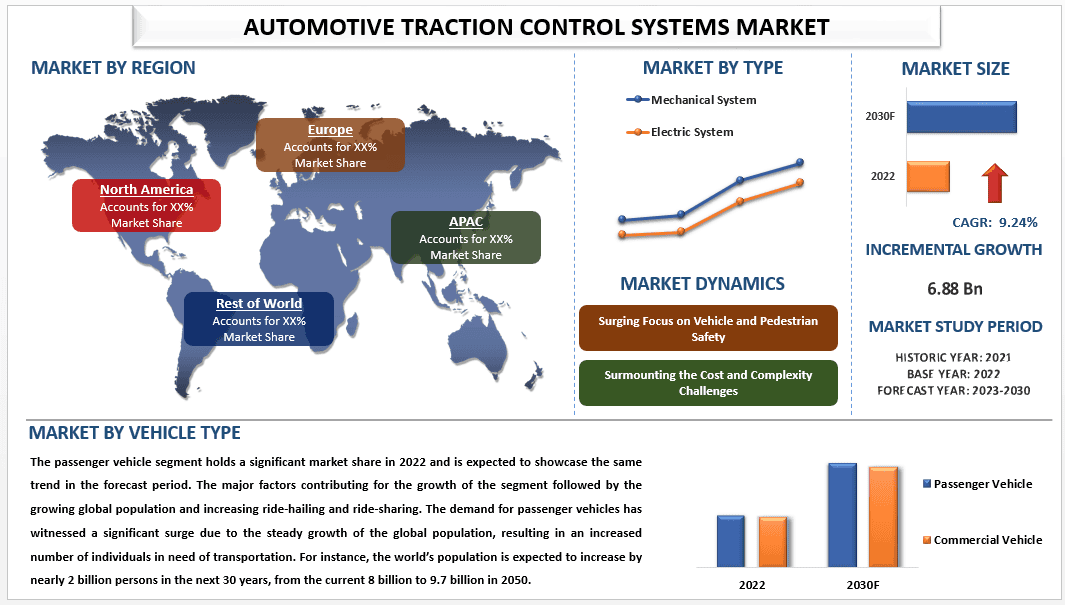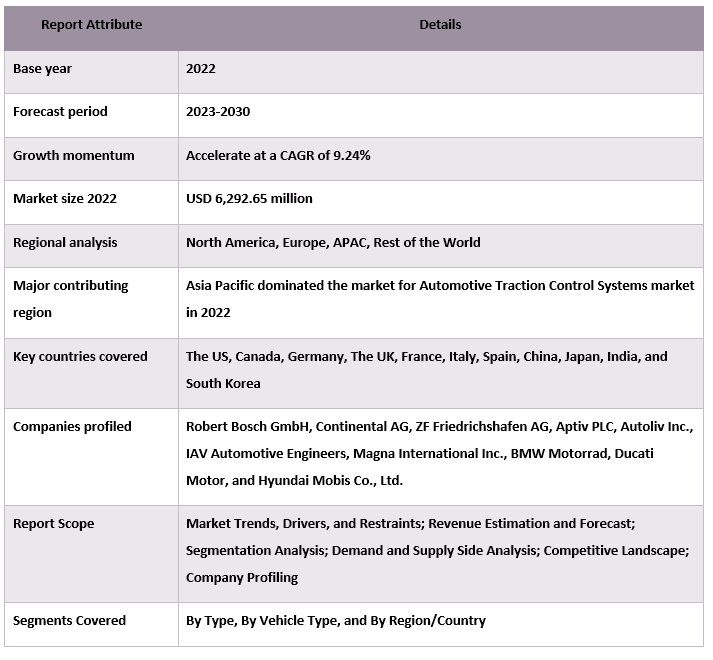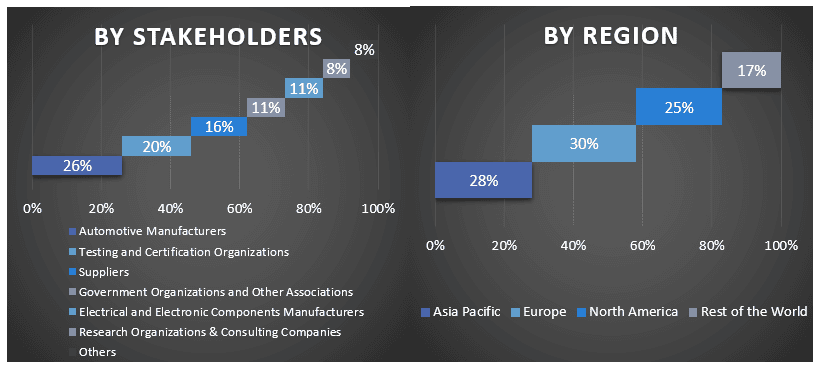- Home
- About Us
- Industry
- Services
- Reading
- Contact Us
Automotive Traction Control Systems Market: Current Analysis and Forecast (2023-2030)
Emphasis on Type (Mechanical System and Electric System); Vehicle Type (Passenger Vehicle and Commercial Vehicle); and Region/Country

The Automotive Traction Control Systems Market is expected to grow at a strong CAGR of around 9.24% during the forecast period due to the stringent government mandates and NCAP protocols. Governments worldwide have implemented more stringent laws and testing procedures to ensure the use of traction control and ESC. The National Highway Traffic Safety Administration (NHTSA) has set a requirement that all vehicles in the US weighing less than 10,000 lbs must have ESC by 2022. Similarly, the EU regulations mandate the deployment of ESC in all new car models. Additionally, Bharat NCAP, as part of its Safer Cars for India initiative, assigns higher safety ratings to cars equipped with traction control.
These regulations have prompted major OEMs such as VW, Toyota, and Hyundai to universally adopt traction systems. For example, Maruti Suzuki has added ESC to its models to comply with the stricter Indian regulations. The primary motivation behind implementing traction control is to ensure regulatory compliance. With China also mandating the use of ESC from 2022 under its C-NCAP protocol and considering its position as the largest car market globally, regulatory pressures are significantly driving the adoption of traction systems across major economies. Furthermore, these mandates have positive spillover effects, encouraging automakers to incorporate more advanced vehicle stability controls like torque vectoring. As a result, traction systems are becoming essential features to meet safety regulations and testing protocols.
Some of the major players operating in the market include Robert Bosch GmbH, Continental AG, ZF Friedrichshafen AG, Aptiv PLC, Autoliv Inc., IAV Automotive Engineers, Magna International Inc., BMW Motorrad, Ducati Motor, and Hyundai Mobis Co., Ltd. Several M&As along with partnerships have been undertaken by these players to facilitate customers with hi-tech and innovative products/technologies.
Insights Presented in the Report
“Amongst type, the electrical system segment dominated the market in 2022.”
Based on type, the market is bifurcated into mechanical system and electrical system. The electrical system segment dominated the market in 2022 and is expected to show the same fashion in the forecast period. The major factors contributing for the growth are the growing transportation and logistics industry which has recognized the benefits of electric vehicles for reducing fuel costs and emissions. Delivery companies, taxi services, and public transportation systems have started incorporating electric vehicles into their fleets, driving the demand for electrical traction control systems. Various governments worldwide have implemented strict emissions standards and incentives to boost the adoption of electric vehicles. The mechanical system in automatic traction control has emerged as crucial due to its reliability and versatility. With a growing emphasis on road safety, governments and organizations worldwide are actively promoting the adoption of technology that minimizes accidents and improves driving conditions. The mechanical system, with its ability to manage wheel slippage and optimize traction in real-time, has gained immense traction among automakers and consumers alike.
“Amongst vehicle type, the less than 6-inches segment generated the highest revenue in 2022.”
- Based on vehicle type, the market is bifurcated into passenger vehicle and commercial vehicle. The passenger vehicle segment holds a significant market share in 2022 and is expected to showcase the same trend in the forecast period. The major factors contributing to the growth of the segment followed by the growing global population and increasing ride-hailing and ridesharing. The demand for passenger vehicles has witnessed a significant surge due to the steady growth of the global population, resulting in an increased number of individuals in need of transportation. For instance, the world’s population is expected to increase by nearly 2 billion persons in the next 30 years, from the current 8 billion to 9.7 billion in 2050. Moreover, ATCS plays a crucial role in enhancing vehicle performance and maximizing fuel efficiency. By automatically adapting power distribution to the wheels, these advanced systems effectively eliminate energy wastage caused by wheel spin. Consequently, passenger vehicles equipped with ATCS witness a notable enhancement in fuel economy, appealing to environmentally conscious consumers and offering substantial long-term financial benefits. Additionally, the increasing global trend towards electric mobility has significantly boosted the need for automatic traction control systems. For instance, in 2023, according to the report published by International Energy Agency, passenger electric cars are surging in popularity and estimated that 18% of new cars sold in 2023 will be electric. Moreover, electric car markets are seeing exponential growth as sales exceeded 10 million in 2022, and the share of electric cars in total sales has more than tripled in three years, from around 4% in 2020 to 14% in 2022.
Automotive Traction Control Systems Market Report Coverage

“Asia Pacific dominated the market for Automotive Traction Control Systems market in 2022.”
The Asia Pacific automotive traction control systems market dominated the market and is expected to behave in the same fashion in the forecast period. The growth is primarily driven by increasing population and demand for transportation, technological advancements, and growing urbanization. The Asia Pacific region is the home of 60% of the world’s population dominated by China and India. The Asia Pacific region has seen the highest growth for the automobile market in the last few years. The growth is primarily driven by increasing population, demand for transportation, technological advancements, and growing infrastructure and urbanization. The Asia Pacific region is the home of 60% of the world’s population dominated by India and China. Major automobile manufacturers lie in the same region such as Honda, Suzuki, Hyubdai, Mahindra, KIA, and Changan. These companies accelerated sales demand and increased the market for traction control system in the region. For instance, according to the report published by Organisation Internationale des Constructeurs d’Automobiles, the total number of passenger vehicles sold was 28.29 million units in the year 2021 from the five major countries increased to 31.08 million units in 2022.
Reasons to buy this report:
- The study includes market sizing and forecasting analysis validated by authenticated key industry experts.
- The report presents a quick review of overall industry performance at one glance.
- The report covers an in-depth analysis of prominent industry peers with a primary focus on key business financials, product portfolios, expansion strategies, and recent developments.
- Detailed examination of drivers, restraints, key trends, and opportunities prevailing in the industry.
- The study comprehensively covers the market across different segments.
- Deep dive regional level analysis of the industry.
Customization Options:
The global Automotive Traction Control Systems market can further be customized as per the requirement or any other market segment. Besides this, UMI understands that you may have your own business needs, hence feel free to contact us to get a report that completely suits your requirements.
Table of Content
Research Methodology for the Automotive Traction Control Systems Market Analysis (2023-2030)
Analyzing the historical market, estimating the current market, and forecasting the future market of the global Automotive Traction Control Systems market were the three major steps undertaken to create and analyze the adoption of automotive traction control systems in major regions globally. Exhaustive secondary research was conducted to collect the historical market numbers and estimate the current market size. Secondly, to validate these insights, numerous findings and assumptions were taken into consideration. Moreover, exhaustive primary interviews were also conducted, with industry experts across the value chain of the global automotive traction control systems market. Post assumption and validation of market numbers through primary interviews, we employed a top-down/bottom-up approach to forecasting the complete market size. Thereafter, market breakdown and data triangulation methods were adopted to estimate and analyze the market size of segments and sub-segments of the industry pertains to. Detailed methodology is explained below:
Analysis of Historical Market Size
Step 1: In-Depth Study of Secondary Sources:
A detailed secondary study was conducted to obtain the historical market size of the Automotive Traction Control Systems market through company internal sources such as annual reports & financial statements, performance presentations, press releases, etc., and external sources including journals, news & articles, government publications, competitor publications, sector reports, third-party database, and other credible publications.
Step 2: Market Segmentation:
After obtaining the historical market size of the automotive traction control systems market, we conducted a detailed secondary analysis to gather historical market insights and share for different segments & sub-segments for major regions. Major segments are included in the report such as type and vehicle type. Further country-level analyses were conducted to evaluate the overall adoption of testing models in that region.
Step 3: Factor Analysis:
After acquiring the historical market size of different segments and sub-segments, we conducted a detailed factor analysis to estimate the current market size of the automotive traction control systems market. Further, we conducted factor analysis using dependent and independent variables such as type, and vehicle type of the automotive traction control systems market. A thorough analysis was conducted of demand and supply-side scenarios considering top partnerships, mergers and acquisitions, business expansion, and product launches in the Automotive Traction Control Systems market sector across the globe.
Current Market Size Estimate & Forecast
Current Market Sizing: Based on actionable insights from the above 3 steps, we arrived at the current market size, key players in the global Automotive Traction Control Systems market, and market shares of the segments. All the required percentage shares split, and market breakdowns were determined using the above-mentioned secondary approach and were verified through primary interviews.
Estimation & Forecasting: For market estimation and forecast, weights were assigned to different factors including drivers & trends, restraints, and opportunities available for the stakeholders. After analyzing these factors, relevant forecasting techniques i.e., the top-down/bottom-up approach were applied to arrive at the market forecast for 2030 for different segments and sub-segments across the major markets globally. The research methodology adopted to estimate the market size encompasses:
- The industry’s market size, in terms of revenue (USD) and the adoption rate of the Automotive Traction Control Systems market across the major markets domestically.
- All percentage shares, splits, and breakdowns of market segments and sub-segments.
- Key players in the global automotive traction control systems market in terms of products offered. Also, the growth strategies adopted by these players to compete in the fast-growing market.
Market Size and Share Validation
Primary Research: In-depth interviews were conducted with the Key Opinion Leaders (KOLs) including Top Level Executives (CXO/VPs, Sales Head, Marketing Head, Operational Head, Regional Head, Country Head, etc.) across major regions. Primary research findings were then summarized, and statistical analysis was performed to prove the stated hypothesis. Inputs from primary research were consolidated with secondary findings, hence turning information into actionable insights.
Split of Primary Participants in Different Regions

Market Engineering
The data triangulation technique was employed to complete the overall market estimation and to arrive at precise statistical numbers for each segment and sub-segment of the global Automotive Traction Control Systems market, data was split into several segments & sub-segments after studying various parameters and trends in the areas of type and vehicle type in the global automotive traction control systems market.
The main objective of the Automotive Traction Control Systems Market Study
The current & future market trends of the global Automotive Traction Control Systems market were pinpointed in the study. Investors can gain strategic insights to base their discretion for investments on the qualitative and quantitative analysis performed in the study. Current and future market trends determined the overall attractiveness of the market at a regional level, providing a platform for the industrial participant to exploit the untapped market to benefit from a first-mover advantage. Other quantitative goals of the studies include:
- Analyze the current and forecast market size of the automotive traction control systems market in terms of value (USD). Also, analyze the current and forecast market size of different segments and sub-segments.
- Segments in the study include areas of type and vehicle type.
- Define and analyze the regulatory framework for the automotive traction control systems
- Analyze the value chain involved with the presence of various intermediaries, along with analyzing customer and competitor behaviors of the industry.
- Analyze the current and forecast market size of the automotive traction control systems market for the major region.
- Major countries of regions studied in the report include Asia Pacific, Europe, North America, and the Rest of the World
- Company profile of the automotive traction control systems market and the growth strategies adopted by the market players to sustain in the fast-growing market.
- Deep dive regional level analysis of the industry
Frequently Asked Questions FAQs
Q1: What is the current market size and growth potential of the global Automotive Traction Control Systems market?
Q2: What are the driving factors for the growth of the global Automotive Traction Control Systems Market?
Q3: Which segment has the largest share of the global Automotive Traction Control Systems market by Vehicle Type?
Q4: What are the emerging technologies and trends in the global Automotive Traction Control Systems market?
Q5: Which region will dominate the global Automotive Traction Control Systems market?
Q6: Who are the key players operating in the global Automotive Traction Control Systems market?
Related Reports
Customers who bought this item also bought










